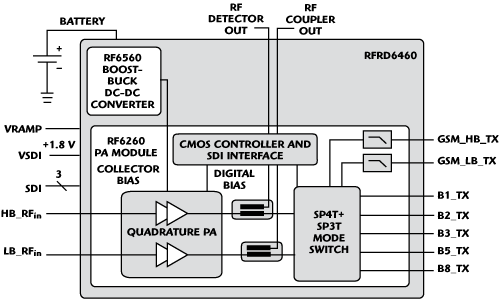
As 4G and LTE technology captures much of the RF design community’s attention, handset OEMs, chip manufacturers and network providers see incredible growth opportunities in the smartphone emerging market, where lack of computers and wired infrastructure positions mobile devices as the best opportunity for people to connect to the Internet. Serving this global market requires a cost-effective, battery efficient, multi-band RF front-end with performance suitable for 3G networks. RFMD is addressing this need with its RFRD6460 3G multi-band, multimode PowerSmart™ Power Platform, the first plug-and-play global smartphone power platform.
The new PowerSmart product platform meets the widely varying needs of mobile operators and provides the capability to efficiently move as the user moves—between voice and data, between mobile operators, and between regions of the world. PowerSmart’s RF configurability enables a solution that covers up to nine frequency bands and six modes of operation while taking only 50 percent of the footprint and 75 percent of the cost required by traditional architectures, all while maintaining the world’s best 2G TRP performance, best-in-class 3G current consumption at all power levels, and the lowest peak power thermal load of any 3G front-end solution.
PowerSmart and PowerCore Technology
The RF Configurable PowerCore™ at the heart of each PowerSmart platform incorporates all power amplification and RF power management functionality. RFMD’s modulation scheme agnostic PowerSmart platforms also include all the necessary switching and signal conditioning functionality in a compact reference design, providing smartphone manufacturers a single scalable source for the entire cellular front-end.

Figure 1 PowerSmart™ platform with PowerCore technology.
PowerCore enables the ability to maximize efficiency across power levels, data rates and during non-ideal load conditions (VSWR), providing performance and battery life customization without hardware changes. Firmware references use Look-Up-Tables (LUT) to write settings via digital interface. In response, the built-in controller sets the bias for each stage of amplification while the integrated power management IC sets the collector voltage (see Figure 1).
The PowerCore LUT allows the RFRD6460 to meet multiple market/mobile operator needs. For example, in standard set-up the controller can bias the power amplifiers at a total battery current of 440 mA in order to deliver 23.5 dBm at an ACLR of -35 dBc into a poorly matched load (VSWR of 3:1), or the controller can be set for either relaxed mode (battery current of 390 mA) for the same output power and -38 dBc ACLR into a 50 ohm load, or the battery current can be reduced to under 300 mA to operate in relaxed power out mode (Pout = 22.5 dBm, -38 dBc ACLR into a 50 ohm load), all through the LUT control.

Figure 2 Functional block diagram of RFRD6460 front-end module.
RFRD6460
The RFRD6460 is comprised of two separate component placements: The RF6260 (power amplifier module) and the RF6560 (boost-buck DC-to-DC converter) integrated into a single module. This device features the first RF configurable power core, designed to seamlessly merge RFMD’s VSWR-tolerant, quadrature power amplifier technology with its patented power management technology. The technology dramatically reduces the size of the front-end solution by enabling replacement of discrete configurations using traditional PAs operating with DC-DC converters, commonly used in 3G front-ends (see Figure 2).
With scalable band coverage up to five 3G bands (penta-band), 2 LB, 3 HB (Bands 1-6 and 8-10) of W-CDMA/HSPA+ operation and/or other linear modes of operation (CDMA, TD-SCDMA, LTE, WiMAX), the RFRD6460 provides extensive flexibility and customization, accelerating the time to market for OEMs targeting smartphones and mobile Internet devices (MID). The RFRD6460 is able to meet OEM and mobile operator band requirements with no hardware changes and no post-power platform matching, saving both time and R&D investment.
Summary of Features
- Best-in-class 3G current consumption at all power levels (24, 22 and 10 dBm, DG.09)
- No PA Matching required
- Scalable band coverage: Up to five 3G bands (penta-band), 2 LB, 3 HB (Bands 1-6 and 8-10)
- WLAN, Bluetooth®, GPS coexistence
- Quad-band GSM/EDGE
- Modes: GSM, EDGE and W-CDMA/HSPA with capability for other linear modulations (CDMA, TD-SCDMA, LTE, WiMAX)
- SDI Interface for ease of programming and control
- Exceptional 2G TRP performance
- Fully adjustable performance via firmware changes not hardware
- “Future-proof” to accommodate unforeseen changes:
- Post-PA component changes (ex. Duplexer IL changes, ASM IL changes, return loss performance from antennas)
- Already accommodates LTE modulation with no MPR
- Post-PA component changes (ex. Duplexer IL changes, ASM IL changes, return loss performance from antennas)
- Production ready.
RFMD
Greensboro, NC
(336) 664-1233
www.rfmd.com
